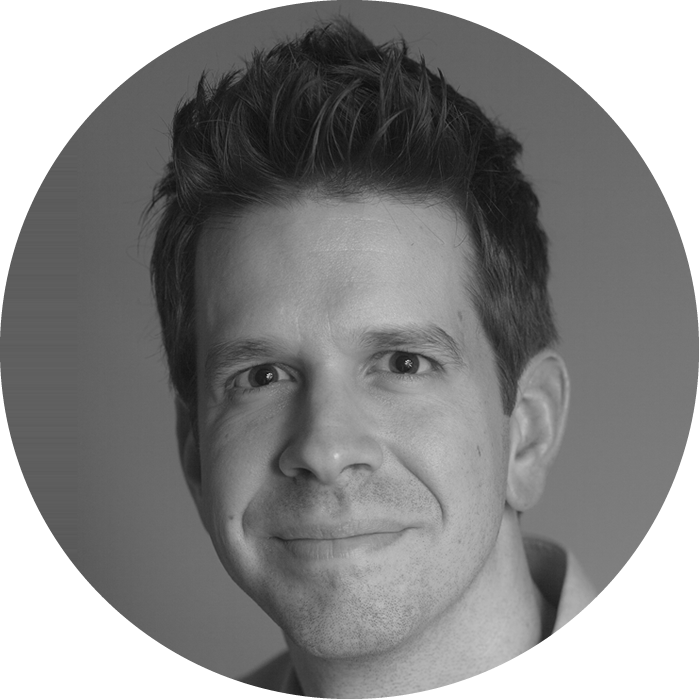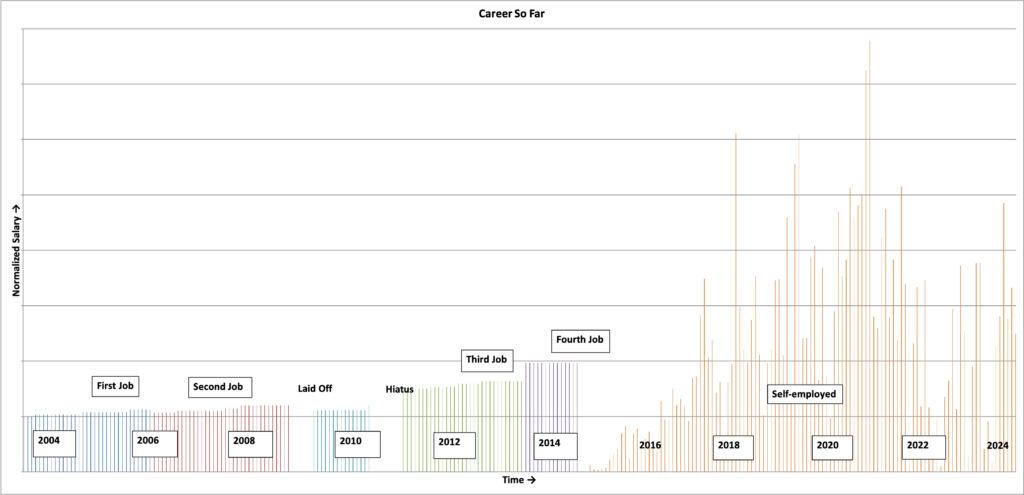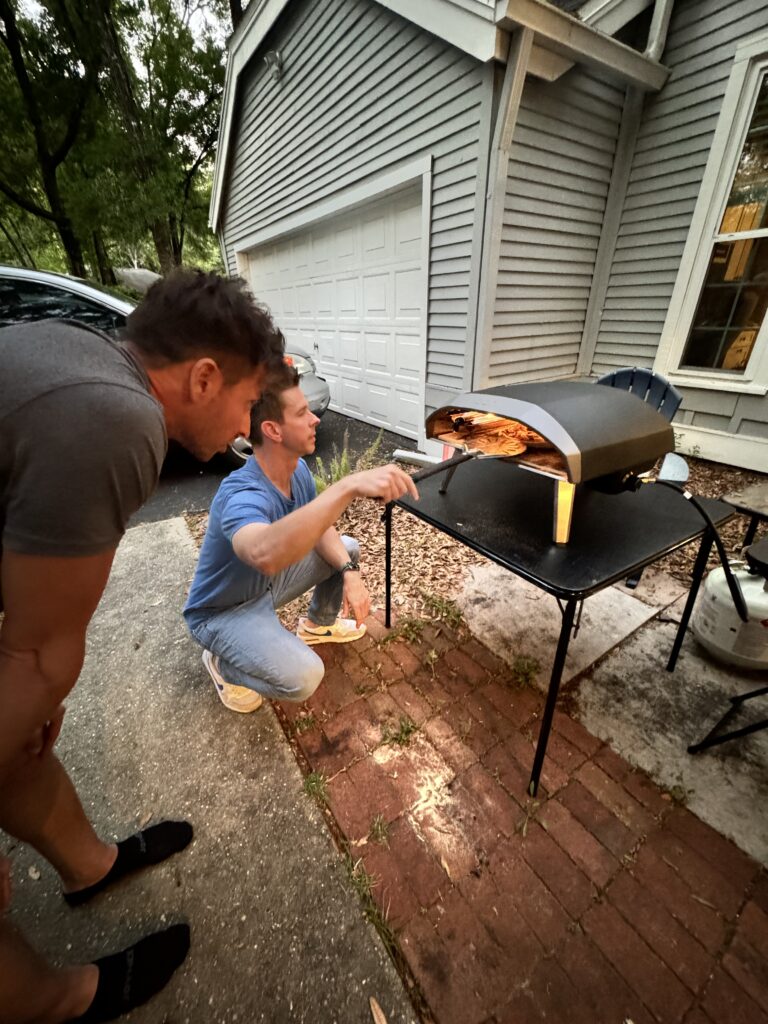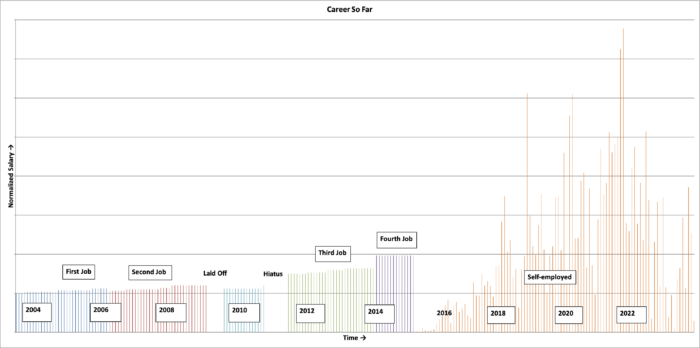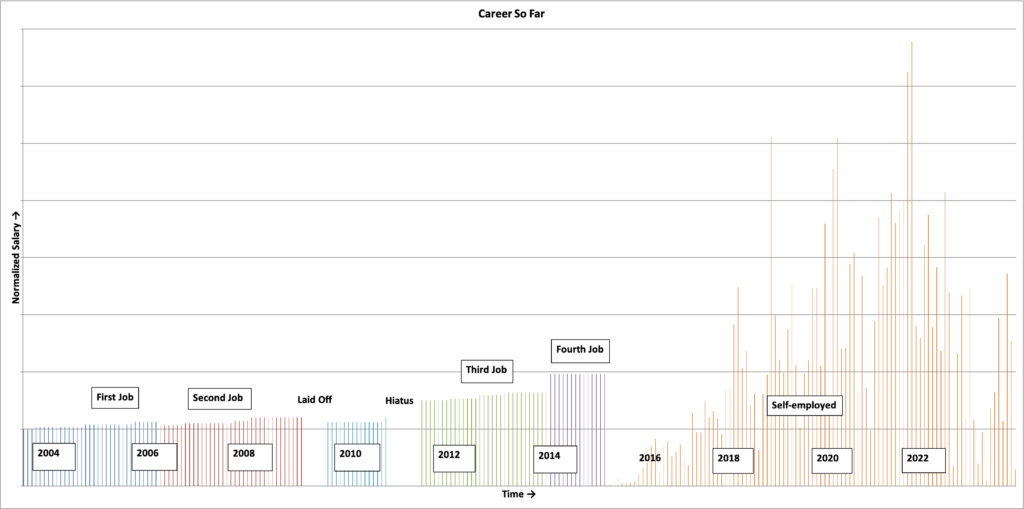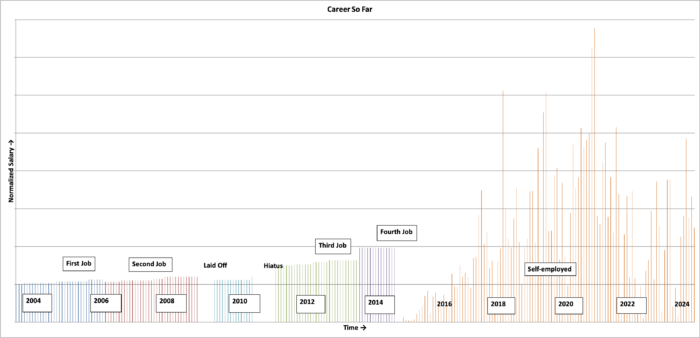
It took a couple of years, but it finally feels like I’m running a business again. When I saw the first signs of a downturn in my business back in 2022, I had no idea it would be a two-year slump. Six months? Sure. A year? hard to believe, but within the realm of possibility. But two full years? That was well beyond the worst-case scenario I had mapped out.
So 2023 was just about survival, and 2024 turned into a game of financial chess, moving financial pieces around the board to avoid long-term damage while continuing to survive. But the year overall was pretty good and would’ve been really good if not for a terrible Q2. The year ended on a positive note via the best December I can remember for my business.
Because of the financial uncertainty, I didn’t really take any trips this year. Those who know me well know that I’m actually totally fine with this. I’m a homebody and am perfectly content to just hang out in Gainesville and follow my routine. That’s a great characteristic to have when expensive vacations and other trips just aren’t in the cards.
The business grew by about 50% this year, which was great! I’m hoping to do that again this year (2025).
I continued my obsession with pickleball and continued to make meaningful progress, even starting to teach lessons occasionally. It’s fun to be competent enough to teach others, and my students have all had a great time so far. My learning style—extremely technical and robotic—means I’m particularly well suited to teach others how to play because I’m keenly aware of all the small little things that go into each shot. If I were a natural, I might have less awareness of the fine movements that go into each shot, and I would not be as good at teaching.
All in all, 2024 turned out to be a really good year. For the first time in a couple years, I had stints of relatively low financial stress. My pickleball game improved. My health was great. My family, friends, and community are all great. If 2025 is as good as 2024, I’ll be pretty lucky.
Ok, onto the detailed recap…
2024 Goal review
I once had a boss who said, “We had two objectives and we hit 50% of them.” That was me this year.
100% business growth
This was a miss, but I still grew about 50%. If it weren’t for a terrible Q2 (literally like 15% of the average revenue for the other quarters), I actually would’ve been pretty close to this goal, if not right at it.
Make progress toward 4.5 in pickleball
Absolutely nailed this and probably did better than I had hoped. I finished third in a 4.0 Men’s Doubles tourney earlier in the year, and made significant improvements after that tourney. I’m not at 4.5 yet, but I’m definitely on my way.
2024 Year in Review – Business
The headline is that the business grew this year for the first time since 2021. Not only had it not grown since 2021, it had shrunk substantially each year since then (last year’s revenue was only about 37% of 2021’s revenue). So “down significantly each year” to “up 50% this year” is a big turnaround and hopefully the beginning of a momentum shift.
Since the business shrank for a while, even a solid growth year like this one isn’t enough to get back to where it was. But I am hopeful that it’s entering a new growth phase and that I’ll be back to where I was in 2021 before long. Only time will tell.
I think there were two main drivers:
- After freezing up a couple of years ago, the tech hiring market has returned to something more normal-ish that looks like the 2019 hiring market.
- My work to focus the business on “high earners” (mostly executives and senior leaders at big companies) has paid off.
If I had to weight each of those, I would say it’s 30% tech hiring, and 70% focusing on high earners.
Here’s my monthly income chart, which I’ve been maintaining for pretty much my entire career. You can clearly see the big drop-off in late 2022, then a two-year drought with occasional spikes, and a consistent run of good months to close out 2024. Hopefully that resurgence will continue through 2025 and beyond.
Stats
Here are the stats that I typically track:
- Visits to FearlessSalaryNegotiation.com: 160,000 (down from a reported 700,000 in 2023)
- Unique page views: About 250,000 (down from a guess of “under 1M”)
- Total email subscribers at the end of the year: About 24,000 (down about 7% year over year)
- Product sales through the site: About 20 (down from about 40)
- Coaching applications: 80 (up from 26)
- Coaching clients: 17 (up from about 11)
- Coaching conversion rate (from prospect to client) was 21% (down from 42%)
Coaching revenue was up about 70% year over year.
I’ve spent the past 18 months or so essentially rebuilding the business, and these stats reflect that work. My first phase of the business was almost entirely SEO-focused: more traffic, more product sales, more coaching prospects. In its heyday, my site got over 1M organic search visitors a year. Now it’s more like 100k or so. There are lots of reasons for that dramatic drop-off—some related to my own SEO skills, some related to the tech hiring reset a couple years ago, and some related to exogenous factors like “tons of giant companies started focusing on SEO for the things I previously dominated by just existing”—but the result is that I get far less traffic to my site now than I used to.
That’s frustrating because I put so much work into ranking in Google and getting lots of organic traffic, but very few (maybe no?) luxury brands primarily depend on organic search traffic to drive revenue.
Instead, they depend on word of mouth (like referrals), loyal customers, brand equity and other signals. All of those things are growing and positive for my business.
That’s only possible because I’ve been at this for almost a decade, and I’ve continued to evolve the business over time.
I’ll write about this in more detail later, but I just wanted to call out that yes, my SEO traffic has tanked and yes, that’s frustrating, but also no, that’s not necessarily a sign that the business is suffering. It may actually be a sign that the business is growing into the business I’ve been trying to build for years now.
I should also note the huge increase in “coaching applications”, which is probably an anachronistic way to think about inbound interest in my coaching offering. I’ve overhauled my prospect onboarding process so that rather than applying to work with me, then booking an intro call, pretty much anyone can just book an intro call any time on short notice.
I did this for a few reasons, but the main one is that more conversations leads to more information about what people are looking for. So that uptick in “coaching applications” isn’t a typo per se but is an artifact of a substantial change in how I identify and onboard potential clients.
Big misses
I had two very big misses this year that would’ve literally meant life-changing money.
One was a partnership that I had been dancing around for a couple of years. I believe that would have been very lucrative, but they decided to go a different direction after literally two years of talking about it. This was disappointing, but not entirely unexpected, and I’ve learned to be pretty pessimistic about big deals until the ink has dried.
I also had an unusual business negotiation opportunity for a client that would’ve potentially brought in a total of mid-six figures of revenue over the next few years if it had gone through, but that deal fell apart at the finish line.
That last one was really painful because I think I did everything right with a laser focus on doing what was best for my client, but the two parties couldn’t come to terms.
Sometimes things just don’t work out, but those two deals both falling through really stung.
Becoming the go-to Salary Negotiation Coach for Executives
Since I started the business, I’ve been on two parallel tracks: Help as many people as possible; create as much value as possible for each client, and capture some of that created value.
For several years, I described this dual-track approach as “I’m basically running two businesses”. One business was an info-product business, selling books, courses, templates and that sort of thing. The other business was my coaching business, which is a 1-on-1 service offering.
The idea was to create a sort of ladder from “free” to “high-dollar” so that people could find the right entry point into my world, matching their experience and budget. That is exactly how it worked for the first five-ish years of the business, and then something interesting started happening: The rungs on the ladder started to fall away, leaving pretty much just the top step (my coaching).
Rather than scaling product revenue alongside coaching revenue, product revenue has steadily trailed off as coaching revenue has grown (especially on a per-client basis). I tried to address this with Salary Negotiation Mastery, which is a premium self-paced course for people who couldn’t or shouldn’t hire me, but that never really took off.
Salary Negotiation Mastery: Great course, bad market timing
In hindsight, I can see that there were a couple of things going on.
First, the traditional market for info-products in general has just been shrinking. I was unlucky to launch Salary Negotiation Mastery directly into this particular headwind. At first, I thought maybe I just missed the mark with the course, despite significant investment in the design and delivery of it. But I can now see that the market itself was changing: pretty much everyone I know who depended on “online courses” for income a few years ago has had to make significant changes and people I know who tried launching similar premium courses had similar results.
I think the reasons for this shift are multi-factorial, but the biggie is that people are going to YouTube and other free channels for pretty-darn-good training and Q&A. And the economic stagnation that seemed to start in late 2022 also squeezed budgets and made people hesitant to “invest” in that sort of thing.
Second, I have continually been moving my coaching offering further up the org chart. Rather than sort of stretching the ladder, this move has broken the ladder. I have become known as “the guy to call for executive comp negotiation”, and that’s very different than “the salary negotiation guy” that I was when I started the business. It’s different in terms of perception, but also in terms of branding and presentation. I’m building a luxury brand, and that’s essentially incompatible with a business that does volume for courses and products.
It’s not impossible to sell products as a luxury service company, but it’s difficult and I just haven’t figured it out.
In some ways, this is really discouraging. The main reason I developed Salary Negotiation Mastery was to solve the “lumpiness” problem: my income pretty much starts at zero every month, and it goes up when I book clients. That’s not strictly true because I have result fees that often come in over time, but I don’t really have a monthly baseline for expected revenue from, say, course sales and that sort of thing. Having that monthly baseline—even just enough to pay the mortgage—would really take the pressure off, and I just haven’t figured out how to do it (at least not since I had a thriving info-product business many years ago).
But in many ways, this is extremely encouraging. As weird as it is to say, I basically created this industry (the salary negotiation coaching industry). I was not the first to write or talk about salary negotiation, but I was the first or one of the first to build a service offering around it, and I’m pretty darn sure I was the first to build a premium service offering around it (meaning: I don’t charge hourly, and average fees I collect look more like B2B consulting than B2C consulting).
I have been working to move up the org chart—entry-level engineers, then experienced engineers, then senior engineers and engineering managers, then leaders, and now “high earners”, who are executives and leaders—for many years, and I have now done that pretty well. Part of that was gaining experience with executive comp negotiations, part of it was branding and positioning, part of it was pricing, part of it was longevity.
This year, I worked with three different clients for whom this was their third time working with me. All three of them have been leveling up their careers for years now, and they reach out to me when they make a move. One of them told me that his job search process is basically “look for roles, get interviews, get offers, hire Josh”.
That’s only possible because I have simply existed for so long now. It also demonstrates the extremely good value of my service offering: They know the playbook, they have seen me work, but they still hire me and pay me more than thy did last time because they want to be sure they get the absolute best result. And they’re even more enthusiastic about my service now than they were when we first worked together.
The result of all this work over many years is that I’ve had several people (“high earners”, but even like “ultra-high earners” making seven figures) reach out to work together and explicitly say, “I looked at some other options, but you’re obviously the guy to work with for executive comp negotiations”. Some of them have even said they had previously worked with other comp negotiators but felt the experience lacking.
Quick aside: How I think about competitors
This is an aside because I don’t talk about competitors much. That’s partially because I truly don’t think there are actual competitors to what I do.
The main difference between me and almost every other “salary negotiation service” out there is that I am literally a professional salary negotiator and not, say, a former recruiter for this company or that company. Do recruiters have experience negotiating job offers? Yes they do. Do recruiters have experience doing what I do? They do not.
That may seem like marketing, but when negotiating a seven-figure comp package, a single sentence could yield a marginal multiple-six-figures to the job offer. I write those sentences all the time, and part of the magic is in knowing what to ask for and when to ask for it, but also in the how to make the ask, how long to wait before sending an email, and other extremely subtle things that are just muscle memory for me.
So that all adds up to, say, a client who previously worked with a “competitor” and paid them $3,000 only to feel that they didn’t really get anything for their investment but a poorly written email. Then they work with me, ultimately paying me almost $25,000 and they say, “[The cost for your service] was definitely more than I expected when we started, but I’m so happy with this result!”
$25,000 is a lot of money, but it’s a pittance compared to the extra $200,000 that client will put in the bank next year because of our work. And the $100,000 the next year. And the $110,000 the year after that.
End aside…
All that to say: Mission accomplished! I’m building the business I have been trying to build for years, and it’s working. But the success of the business also means it’s very, very hard to build a parallel product business and I have more or less failed at that.
Maybe I should write more about this move to a luxury brand
I’m not a big fan of the “it worked for me” genre, but I am starting to wonder if it’s time to write about how I’ve built this particular business. It’s starting to feel like a similar story to the origin story of the business itself: I just happened to have a bunch of overlapping skills that I chose to employ in this particular way, and here I am.
The luxury business wasn’t really a goal, it was a means to an end. “How do I continue to move up the org chart to find higher-leverage places to use this valuable skill I have developed?” The answer was: “I think I have to build a luxury brand, or at least model my business on how luxury brands are built.”
That plan is working and should continue to work. If I had a time machine and went back to 2015 when I was writing Fearless Salary Negotiation and told 2015 Josh that, “This book will eventually be the basis for a business where clients happily pay you tens of thousands of dollars to help them negotiate job offers”, I honestly don’t think I would have believed it. That wasn’t what I was trying to do with the book, and I don’t think I would’ve understood how the book (which launched at like $9.99 on Amazon) could lead to that outcome.
But that’s where it led, and each step along the way was an intentional move to where the puck was going. I think there are a lot of B2C service offerings that could really benefit from moving toward a high-end luxury model. So maybe I’ll write about how I think that should be done.
I haven’t done this yet because it would almost certainly be a labor of love that wouldn’t make enough money to justify the time investment. But Fearless Salary Negotiation itself was a labor of love and look how that turned out!
2024 Year in Review – Personal
On the personal side, I had a really good year. Part of that was due to my business finally feeling like a business again. I generally felt a lower level of financial stress this year than last year. I also just had a good year in general.
No big trips since I have been trying to watch my finances, but I’m not that big on travel anyway (meaning that my amount of travel doesn’t really affect my feeling of how the year went).
Pickleball: Two steps forward, one step back
This was a very interesting year for pickleball. On one hand, I played my first 4.0 tournament and took bronze. We could have taken silver but for a couple of tactical mistakes with respect to byes, breaks, warmups, timeouts, etc.
I definitely confirmed that I made it to the 4.0 level that I had been targeting since I started playing in 2021.
(If you read that and thought, “three years to get to 4.0”, there’s a lot of history in my previous Year in Review posts, but I’ll summarize by saying: picking up the game was extremely challenging for me as had to learn pretty much everything from first principles while also fighting some pretty tough vision and tracking issues around depth perception and stuff.)
This year, my goal was “make more progress toward 4.5” and I definitely achieved that goal while also realizing it’s a sort of circuitous path. This summer, I was drilling with a friend who is very good (5.5 or so) and I asked for feedback on my third shot drops. I thought I had them pretty much dialed in, but was a little frustrated with inconsistency. I had been hitting third shot drops with the Tutor, aiming at targets, and just found that I was inconstant and occasionally struggled to hit my target.
I figured I would get a tip or two to help me be more consistent so I could go back and hit the Tutor to iron out the kinks. Instead, I got, “Well. Since you asked. You’re doing it totally wrong.” Uh oh.
I quickly learned that while my third shot drop was occasionally very good, it was also occasionally really bad, and it would never be consistent because my form was totally wrong. Furthermore, the lack of form was affecting pretty much every forehand shot I took: third shot drops, resets, speed ups, drives, dinks, all of it.
I’ve been at this sort of juncture before in other sports.
As a college kid, I learned that my somewhat-effective jump shot was actually totally wrong, so I had a friend teach me how to shoot. It took a while, but I got significantly better at basketball.
As an adult, I took a ski lesson and got pretty decent. But eventually got a point where I struggled to control speed on turns. That was because my form was wrong, and I had to change some things by starting over from scratch.
These are never quick changes because first I have to unlearn the wrong way, and then I have to learn the right way. Much, much slower than just learning the right way to begin with.
But I plan to play pickleball for a long time, so I tore down my third shot drop and started over. Unfortunately, I did this about two weeks into a ladder league. The first week, I barely lost on Court 1 (the most advanced court) and got bumped down to Court 2. But that week was the week I started working on my third, and I quickly tumbled down the ladder and ended up on Court 5 because I literally could not hit a third shot. It was brutal and embarrassing.
I hit more than 10,000 third shot drops this summer over many hours. I tanked in the ladder league. I got destroyed for a couple months in pickup and rec games.
But now? My third is better than ever, it’s super reliable as long as I get it warmed up before I play, and I’ve added two variants (twoey and one-hand backhand slice) that are also very good. My “off” days are as good as or better than my “on” days were before. When my third is on, I can literally see my opponents’ brains breaking as they try to figure out if they can volley it before it bounces in the kitchen and they shank their fourth shot into the net.
The upshot of all that work is that all of my other forehand shots are also significantly better. I have a really nice topspin crosscourt dink now. My inside-out topspin dink is very good. My resets are better. So I got to 4.0, tore down my third shot to where I literally could not hit it, and am now heading back to 4.5 with a much improved third shot and far better paddle control.
Giving pickleball lessons
Earlier in the year, a friend (the 5.5 from earlier) and I were talking about how fast pickleball is growing and how it seems like a lot of people want to learn how to play and how to play better. So, basically on a whim, we set up Gainesville Pickleball Coaching.
The market is so new that there aren’t a lot of people giving lessons, so ranking well in Google for local searches was pretty easy. Sure enough, people have been hiring us for lessons pretty much since we set it up.
We’re not like overwhelmed with lessons or anything, but we’re getting a couple customers a month and people really seem to enjoy the training and benefit from it.
What’s unusual is that neither of us is giving lessons to make money (although it’s nice to have some actual income to help fund the improvements I’ve been making to my pickleball courts), but just because we like teaching people and helping them make progress. I’ve been a professional salary negotiation coach for almost a decade, and the reason I chose this line of work is that I just love helping people. My friend also does lots of different types of coaching and has his own wealth management firm—also because he just likes helping people.
What’s great is we both bring totally different experiences to teaching other people pickleball. He’s a natural athlete who picked it up and got pretty good right away. I was horrendous when I started playing, and have had to slowly, methodically learn how to play. Both of those backgrounds enable us to teach people who are at different skill levels using our own unique styles.
Hard conversations
One thing that was both challenging and encouraging is that I had a lot of hard conversations this year. Some were personal, and some were professional. Obviously, I can’t really elaborate, but there’s a lot to be learned from difficult situations.
The reason I’m mentioning this at all is that I have found that one way to navigate difficult conversations (and difficult situations in general) is to have a sort of north star, or sometimes multiple north stars (which I understand breaks the analogy, but so be it) to guide me. A big one is “What is true in this situation?” Another is “What is the right thing to do here, even if it’s not easiest or the thing I most want to do?”
Most of the time, hard conversations will result in one or more people feeling frustrated, angry, disappointed, sad, or other objectively bad things. That can make it even harder to have those hard conversations—I don’t like feeling that way, and I don’t like it when other people feel that way. But having those north stars can help take the focus off of those feelings and turn the focus onto more objective things like what is right, what’s a good outcome, etc.
Looking back, I feel that I did the best I could and made good choices in those situations. It will not always be that way, but just so happens to be that way for this year.
Helping out at church
I’ve been going to the same church (City Church here in Gainesville) for over eight years now, and I’ve slowly found myself getting involved in more and more ways. How I’m involved will continue to change over time, but this is a highlight in my Year in Review post because it’s been so gratifying this year.
It feels good to focus on other people and how I might help them, taking my focus off of myself. Being involved in my church helps me with that.
Pizza and penne nights
I have no idea how many times I made pizza or the penne dish this year, but it was a lot.
Pizza nights started out several years ago, initially as a fun activity to do with my friends and their young kids because the kids love helping make the pies and eating pizza. It has morphed into a super-fun, regular social activity that I schedule with friends. People are always surprised how good homemade pizza can be, and it’s pretty fun making some pies.
I started making my own Neapolitan pizza dough this year and it’s actually pretty good! I’ve also gotten the cooking technique down using my Ooni (that was trickier to get good at than I anticipated). We alternate between Neapolitan-style in the Ooni, and New York-style in a regular home oven.
I also had a lot of chances to make the famous “penne dish” this year. I often make it to celebrate with friends who just had a baby. I call it the “penne night road show” because I bring all the ingredients and my own pot to cook with. They always love it (or at least they say they do). I have pretty good evidence that they’re not just saying that to be nice: at least one of those couples gave the recipe as a Christmas gift to a bunch of other people this year.
That’s definitely the dish I am most famous for, and I’ve probably made it 50-60 times now. I have it perfected and it’s my favorite thing to make and eat.
Home improvement and DIY stuff
Since I bought my house a little over two years ago, I’ve been steadily improving small things to make it just a little bit better. At first, I was basically just trying to get to parity with what I had at my old house in terms of comfort and home automation stuff. That took about a year, and once I got that handled I moved on to making the new house better.
I host a lot of stuff at my house, so my main focus has been on either making my place more hospitable so people are more comfortable here, or on making it easier for me to be hospitable when needed.
Making the house more hospitable can mean small things like having enough comfortable seats for everyone or making it easy to find the things people might need if I can’t help them.
Making it easier to be hospitable means little, almost invisible things like automating lights and thermostats so that when people are coming over I don’t have to manually prep the house to receive them.
For repairs and home improvement stuff, I’ve also defaulted to asking, “Can I do that myself?” instead of “I should call somebody to do that.” Obviously, there’s a lot stuff I can’t do on my own, but if I can do it on my own I like to at least give it a shot. Sometimes the result is that I realize it’s not that hard and it would be silly to hire someone to do it; sometimes the result is that I realize it’s really dumb to do the thing because there are professionals who can do it much faster and cheaper.
Here’s a partial list of stuff I’ve done so far:
- Replaced programmable thermostats with smart thermostats
- Replaced a standard deadbolt with a smart lock
- Replaced a ton of “dumb” light switches with smart ones
- Installed some smart shades to overcome my own laziness in opening blinds so I get more natural light during the day
- Replaced all the smoke and carbon monoxide detectors
- Replaced the old alarm system
- Replaced a hip-high garbage disposal switch that kept getting turned on by accident (and left on until the disposal overheated)
- Replaced a bunch of halogen landscape lights with LEDs, and put smart timers on them so they “know” when sunset is
- Put permanent pickleball lines on my court
- Figured out the house’s ethernet setup and filled some gaps in the wiring
- Replaced the standard drawer slides on some kitchen drawers with quiet-close slides so the drawers stopped randomly opening into people’s shins
- Replaced most of the old air registers
- Snaked some sinks and shower drains
It’s been fun to learn new skills and most of those things aren’t hard with the right YouTube video.
2025 Goals
After a few years of lackluster goal setting, I’m back with some actual goals for 2025! None of these are particularly ambitious, but at least I’m setting goals this year.
50% business growth
If the business grows by 50% again this year, I’ll be within striking distance of 2021’s revenue numbers. It’s weird to aspire to match revenue numbers from four years ago, but such is life as an entrepreneur.
Things were really, really good in 2021, and then the bottom fell out in 2022 and 2023. In 2024, things felt like they started moving in the right direction, and the year ended on a high note that felt like I was running a normal business again.
So after a couple of years of drought, I’m hopeful that I can get back to building and growing instead of just surviving.
Build at least one new revenue stream
In 2021, I had a separate revenue stream from a partnership and it worked great for both the partner and for me. Since then, I’ve talked about partnering with a few other folks, but nothing ever came of it.
This year, I’m talking to a few organizations about partnerships and I would like to make at least one of them work. Now that I’ve moved much more heavily into executive compensation coaching, that leaves quite a bit of latitude for me to help folks who are not yet executives (and communities of those folks) without cannibalizing my core business.
I think there’s a lot of room for me to help a lot of people if I can find the right partners.
Improve to at least a 4.5 in pickleball
I’ll be pretty disappointed if I don’t get this goal. I finished 2024 strong and I think I’ve finally worked through most of the main bottlenecks to hitting 4.5. With persistence and focused practice, I think I can get there in 2025.
As I look further down the road, I think my stretch goal is to get to 5.0. I’m not even sure that’s possible because of my difficulty with depth perception and ball tracking in some lighting situations, but I don’t think it’s unrealistic either. First, I have to get to 4.5, though.
Be more generous
This was a sort of recurring theme in my Goals for a few years, and it fell off the list as I moved into survival mode for a while. That didn’t mean I just totally stopped trying to be generous, but that I was more opportunistic and less intentional.
I want to get back to intentionally looking for opportunities to be generous to those around me.
Find one new go-to dish to cook
I have a nice stable of entrees and desserts that I’m pretty good at and that people like, but it would be nice to add one more to the list this year. I’m thinking “entree” here, but I might also add a dessert.
Make meaningful progress on a book manuscript
It’s time. I have some ideas and I’m feeling motivated.
I started writing my first book, Heads-Up Tournament Poker: Hand-by-Hand, in 2011 and traditionally-published it in 2013. I started writing my second book, Fearless Salary Negotiation: A step-by-step guide to getting paid what you’re worth, in late 2014 and self-published it late 2015.
The self-publishing process was rough and I also immediately pivoted to building video courses to complement the book. The video course creation process may have been more difficult than self-publishing the book, and the combination of the two just sapped all desire to start from scratch and make something new again.
It’s taken almost a decade, but I think I have the itch to write again. The main challenge is figuring out what to write about—I have some ideas that are pretty diverse, so I’ll be able to poke around and see which idea seems right. There’s also an interesting aspect of “writing for AI”, which will make this a new challenge rather than a re-run of the “self-publish a book” challenge from last time.
